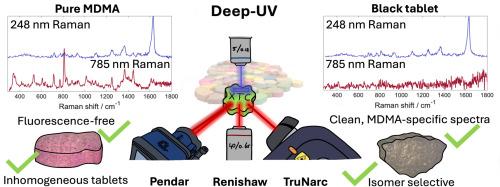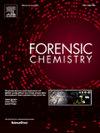共振增强深紫外拉曼光谱法鉴别彩色摇头丸中MDMA
IF 2.2
3区 医学
Q2 CHEMISTRY, ANALYTICAL
引用次数: 0
摘要
在法医毒品执法方面,越来越需要对非法物质进行快速和准确的现场分析。有效的现场方法必须适用于广泛的化合物,包括新兴的设计药物,使合成药物市场多样化。光谱技术,特别是拉曼光谱技术,由于其分子特异性和便携性而前景广阔。然而,荧光干扰限制了它们对复杂、有色和/或不纯样品的使用。本研究探讨了利用深紫外共振拉曼光谱(DUV-RRS)检测摇头丸中MDMA的方法。利用最近商业化的248.6 nm NeCu激光器,建立了内部装置,并将其性能与两种商用手持系统和台式仪器进行了比较。与传统的拉曼系统(785-1064 nm)不同,DUV-RRS在无荧光区域工作,并受益于与MDMA芳香环相连的振动模式的共振增强。这使得即使在低剂量或不均匀片剂中也能进行选择性、灵敏的检测。MDMA在低至1% w/w的浓度下可以可靠地检测到,因为普通赋形剂在该波长下没有共振增强。在MDMA和类似物或异构体之间观察到明显的光谱差异。至关重要的是,DUV-RRS为有色样品提供了干净的mdma特异性光谱,克服了传统拉曼系统的一个关键限制。DUV-RRS不太适合定量分析,可能面临多种吸收物质的挑战,并且系统只有半便携式。尽管如此,随着DUV源小型化的进步,DUV- rrs技术变得越来越可行。在这种情况下,它作为长波长拉曼的有力替代品脱颖而出,为选择性地、实地部署地识别摇头丸片中的合成药物提供了明显的好处。本文章由计算机程序翻译,如有差异,请以英文原文为准。

Resonance-enhanced deep-UV Raman spectroscopy for MDMA identification in colored ecstasy tablets
In forensic drug enforcement, there is a growing need for rapid and accurate on-site analysis of illicit substances. Effective field methods must work across a wide range of compounds, including emerging designer drugs diversifying the synthetic drug market. Spectroscopic techniques, particularly Raman spectroscopy, are promising due to their molecular specificity and portability. However, fluorescence interference limits their use for complex, colored, and/or impure samples.
This study explores the use of deep-ultraviolet resonance Raman spectroscopy (DUV-RRS) for detecting MDMA in ecstasy tablets. Using a recently commercialized 248.6 nm NeCu laser, an in-house setup was built, and its performance was compared with two commercial handheld systems and a benchtop instrument. Unlike conventional Raman systems (785–1064 nm), DUV-RRS operates in a fluorescence-free region and benefits from resonance enhancement of vibrational modes linked to MDMA's aromatic ring. This enables selective, sensitive detection, even in low-dose or inhomogeneous tablets. MDMA was reliably detected at concentrations as low as 1 % w/w, as common excipients show no resonance enhancement at this wavelength. Distinct spectral differences were observed between MDMA and analogues or isomers. Crucially, DUV-RRS yielded clean, MDMA-specific spectra for colored samples, overcoming a key limitation of conventional Raman systems.
DUV-RRS is less suited for quantitative analysis, may face challenges with multiple absorbing substances, and the system is only semi-portable. Nonetheless, as DUV source miniaturization advances, DUV-RRS becomes an increasingly viable technique. In this context, it stands out as a strong alternative to long-wavelength Raman, offering clear benefits for selective, field-deployable identification of synthetic drugs in ecstasy tablets.
求助全文
通过发布文献求助,成功后即可免费获取论文全文。
去求助
来源期刊

Forensic Chemistry
CHEMISTRY, ANALYTICAL-
CiteScore
5.70
自引率
14.80%
发文量
65
审稿时长
46 days
期刊介绍:
Forensic Chemistry publishes high quality manuscripts focusing on the theory, research and application of any chemical science to forensic analysis. The scope of the journal includes fundamental advancements that result in a better understanding of the evidentiary significance derived from the physical and chemical analysis of materials. The scope of Forensic Chemistry will also include the application and or development of any molecular and atomic spectrochemical technique, electrochemical techniques, sensors, surface characterization techniques, mass spectrometry, nuclear magnetic resonance, chemometrics and statistics, and separation sciences (e.g. chromatography) that provide insight into the forensic analysis of materials. Evidential topics of interest to the journal include, but are not limited to, fingerprint analysis, drug analysis, ignitable liquid residue analysis, explosives detection and analysis, the characterization and comparison of trace evidence (glass, fibers, paints and polymers, tapes, soils and other materials), ink and paper analysis, gunshot residue analysis, synthetic pathways for drugs, toxicology and the analysis and chemistry associated with the components of fingermarks. The journal is particularly interested in receiving manuscripts that report advances in the forensic interpretation of chemical evidence. Technology Readiness Level: When submitting an article to Forensic Chemistry, all authors will be asked to self-assign a Technology Readiness Level (TRL) to their article. The purpose of the TRL system is to help readers understand the level of maturity of an idea or method, to help track the evolution of readiness of a given technique or method, and to help filter published articles by the expected ease of implementation in an operation setting within a crime lab.
 求助内容:
求助内容: 应助结果提醒方式:
应助结果提醒方式:


